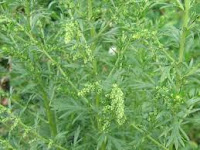Yomogi or Japanese mugwort is related to the common mugwort (Artemisia vulgaris) found in
The genus name Artemisia comes from the Greek goddess Artemis (Roman equivalent of Diana) the goddess of hunting, who is said to have given these plants to Chiron the centaur to practise his healing arts.
The leaves and new shouts or sprouts from this plant are edible, with the blanched leaves being added to the sticky rice dumplings called mochi, which can be found in health food shops in countries other than Japan . It is used in traditional medicine in East Asia where it grows; in China , Japan and Korea . In Japan it is either taken orally or used in moxibustion which is a burning of compact bundles of the herb at acupoints on the body.
It is used to treat inflammatory diseases and inflammation generally, and piles, circulation problems and ailment which arise from these, and is also used to treat cancers, ulcers and digestive problems.
There have been numerous research studies done on this herb in order to discover if the traditional uses can be supported by scientific evidence. However although there are studies, these have not always been replicated, so the evidence is not totally compelling.
It has been found to have anti-inflammatory effects, and it may have neuroprotective actions (“Neuroprotective effect of caffeoylquinic acids from Artemisia princeps Pampanini against oxidative stress-induced toxicity in PC-12 cells”, Lee S. O. et al; in the Journal of Food Science, 2011, Vol. 76 (2) pp 230-6.) The study concludes, “These results indicate that phenolics from A. princeps Pampanini alleviated the oxidative stress and enhanced the viability of PC-12 cells, suggesting that it may be applied as a dietary antineurodegenerative agent in functional foods.”
One study has shown that it can inhibit the growth of tumours in vivo and in particular those of cervical cancer “Standardized flavonoid-rich fraction of Artemisia princeps Pampanini cv. Sajabal induces apoptosis via mitochondrial pathway in human cervical cancer HeLa cells.” Ju H. K. et al in Journal of Ethnopharmacology 2012 May 7; Vol.141 (1):pp. 460-8. Another study suggests that it may in future help in the treatment of asthma as well as being able to inhibit the growth of tumours. (Bae, E.A. et al. Journal of Microbiology, 2007, Vol. 17 (9) pp 1554-7.)
Eupofolin has been extracted from the plant and this flavonoid has been shown to inhibit the growth of several human cancer cells. This is described by Chung, K. S. et al in the Journal of Molecular Nutrition and Food Research, 2010, Vol. 54 September pp.1318-28.
The essential oil from the plant contains eucalyptol (found in eucalyptus trees too) and a-terpineol which can inhibit the growth of bacteria such as Candida. (“Artemisia princeps Pamp. Essential oil and its constituents eucalyptol and α-terpineol ameliorate bacterial vaginosis and vulvovaginal candidiasis in mice by inhibiting bacterial growth and NF-κB activation. Trinh H.T et al.in Planta Medica 2011 Vol. 77 (18) pp. 1996-2002.)
It may also help, if taken in the long term, to combat obesity and diabetes according to Norio Yamamoto et al., in Food and Function issue 1 (2) pp. 45-52, “Anti-obesity and anti-diabetic effects of ethanol extract of Artemisia princeps in C57BL/6 mice fed a high-fat diet”
The leaves have potent antioxidant actions too.
Clearly this plant is worth taking a closer look at as it may have the potential to help us combat several diseases.







cool info!
ReplyDeletevery cool article. thank you. it smells and grows similar to a cross between wormwood and rosemary. very interesting plant.
ReplyDeleteI have long felt a special connection with Herbal Medicine. For one thing is natural, Charlie we went to the same small college in Southern California — Claremont Men’s College — though he dropped out and ultimately enrolled at the Julliard School of the Performing Arts in New York. Had he stayed at Claremont, he would have been a senior the year I started there; I have often kidded that I was the reason he left when he finds out I had herpes. So my life have been lonely like hell all day I couldn't bear the outbreak pain, Tasha then introduce me to Dr Itua who use his herbal medicine to cure her two weeks of drinking it. I place an order form him and he delivers to my post office then I picked it up and used for two weeks all my sore was healed completely no more outbreak I'm honestly telling you this man is a great man, I trust him and his herbal medicine so much I'm sharing this to show my appreciation also to let sick people know there is hope with Dr Itua Herbal Made Medicine.Dr Itua Contact Email.drituaherbalcenter@gmail.com,Whatsapp.+2348149277967
ReplyDeleteHe cures.
Herpes,
STROKE.
Hepatitis
H.P.V TYPE 1 TYPE 2 TYPE 3 AND TYPE 4. TYPE 5.
HIV
SYPHILIS.
Liver/Kidney Inflammatory
Epilepsy
I
ReplyDeleteNice oveview!
I love my princely patch of yomogi, which I received from an herbalist friend - she was given starts by an older Japanese woman, who had listed several benefits and ways she used it.
Yomogi is one of the Okinawa 'Blue Zone' herbs,used daily in rice or saki .... this summer I used some to make mead at solstice - heavenly!
I add to various things I'm cooking, soups, stews, tomorrow, to bone broth!